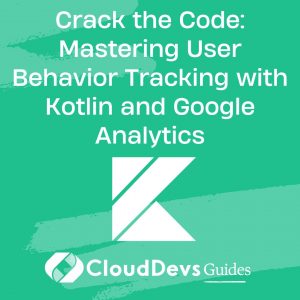Crack the Code: Mastering User Behavior Tracking with Kotlin and Google Analytics
In the fast-paced world of tech startups, understanding your users’ behavior is crucial to staying ahead of the competition. Whether you’re an early-stage startup founder or a tech leader, harnessing the power of Kotlin and Google Analytics can provide you with invaluable insights to fine-tune your app’s performance and user experience.
Table of Contents
1. Why Use Kotlin for Mobile App Development?
Before we delve into the world of user behavior tracking with Google Analytics, let’s briefly explore why Kotlin is a popular choice for mobile app development, especially among the 25 to 40-year-old demographic in the US.
Kotlin, known for its concise syntax and enhanced productivity, is a modern programming language that seamlessly integrates with Java, making it a fantastic choice for Android app development. Its clean and expressive code not only speeds up development but also reduces the likelihood of errors, ensuring a smooth user experience.
2. Setting the Stage: Integrating Google Analytics
Now, let’s get to the heart of the matter: tracking user behavior with Google Analytics. To kick things off, you’ll need to integrate Google Analytics into your Kotlin-based mobile app. Here’s how:
- Create a Google Analytics Account:
First and foremost, set up a Google Analytics account for your project if you haven’t already. This will provide you with a tracking ID that you’ll use in your app.
- Add the Google Analytics SDK:
Incorporate the Google Analytics SDK into your Kotlin project. You can achieve this by adding the necessary dependencies to your project’s build.gradle file.
- Initialize Google Analytics:
In your app’s code, initialize Google Analytics with your tracking ID. This is where Kotlin’s concise syntax shines. Here’s a simple example:
```kotlin val analytics = GoogleAnalytics.getInstance(this) val tracker = analytics.newTracker(R.xml.global_tracker) ```
With these initial steps, you’re ready to start tracking user behavior.
3. Tracking User Behavior with Google Analytics
Now that you’ve set the stage, it’s time to dive into tracking user behavior. Here are some essential actions you can monitor and examples of how this data can benefit your startup:
- User Engagement Metrics:
– Page Views: Keep an eye on which screens or pages users visit most frequently.
– Session Duration: Understand how long users engage with your app.
– Bounce Rate: Identify screens where users tend to exit quickly.
Example: By tracking high bounce rates on a specific screen, you can pinpoint usability issues and improve the user experience—similar to how saas ppc services analyze campaign performance..
- Event Tracking:
– Button Clicks: Monitor interactions with important buttons or features.
– Form Submissions: Track how many users complete sign-up forms or make purchases.
– Video Views: Measure engagement with video content.
Example: If you notice a drop-off in form submissions, you can optimize the form’s design and functionality.
- User Demographics and Interests:
– Age, Gender, Location: Understand your user base better.
– Interests: Discover what topics or products resonate with your audience.
Example: If your startup primarily targets a male demographic in the US, this data can help tailor your marketing efforts effectively.
4. Three External Resources to Dive Deeper
To further enhance your knowledge of tracking user behavior with Kotlin and Google Analytics, here are three external resources worth exploring:
- Google Analytics for Android – https://developers.google.com/analytics: The official documentation provides in-depth guidance on integrating and using Google Analytics in your Kotlin app.
- Kotlin Programming Language – https://kotlinlang.org/: To master Kotlin, this is your go-to resource for comprehensive documentation and tutorials.
- Mobile App Analytics Guide – https://www.appanalytics.io/blog/the-complete-guide-to-mobile-app-analytics: A comprehensive guide that delves into various aspects of mobile app analytics, including user behavior tracking.
Conclusion
Kotlin and Google Analytics form a powerful duo for tracking user behavior in your mobile app. By implementing these tools and diligently analyzing the data they provide, you can make data-driven decisions that help your startup outperform the competition. So, go ahead, embrace Kotlin, integrate Google Analytics, and start gaining insights that will drive your success.
Table of Contents









